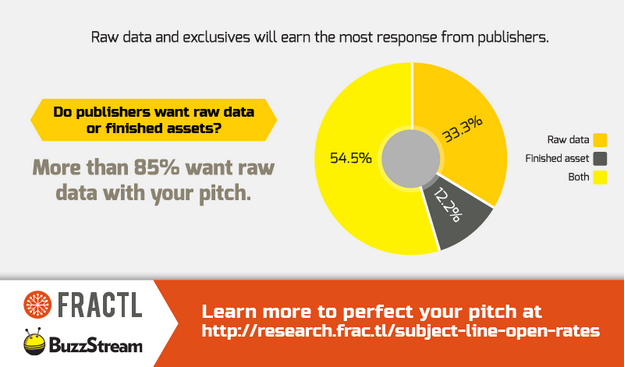This is a guest contribution from Kelsey Libert from Fractl.
The good news: Content is here to stay as a digital marketing powerhouse, giving marketers more opportunities than ever to tune their SEO goals for every stage of the buying cycle.
The bad news: The boom in content marketing has resulted in a veritable avalanche of email for publishers. In fact, some top-tier publishers receive over 300 pitches a day – more than 3x the email volume of the average worker.
What does this mean? Without placements that will reach the right audiences, the quality of your content is a moot point. Competition is tougher than ever in the inboxes of those who are calling the shots on publishing your work; only the best pitches will receive the attention of the most coveted sites. That’s why BuzzStream and Fractl collaborated to survey more than 500 publishers to find out how to break through the noise and improve your content promotion.
Pitch Perfect Subject Lines
The subject line is your first and most important opportunity to capture a publisher’s attention. Honing this one area of your pitching practice can mean the difference between a top-tier placement on HuffingtonPost.com, Mashable.com, or BusinessInsider.com – or weeks of fruitless pitching with your fingers crossed for some low-authority pickups.
Why is the subject line so crucial? 81% of publishers want email pitches, which means the inbox is your best avenue for earning their interest. 85% open emails based on the subject line alone, which means that knowing what they’re looking for will improve your odds of earning their attention. Our survey results tell us that the following six influencers have the most impact on your open rates.
1. Speak to Their Beat
The single most important takeaway from our survey might just be this: more than 60% of publishers told us that the best subject lines should be tailored to their beat. This means that you need to use that limited space to let them know that you both understand what they cover and have something relevant to share with them.
More than 50% agreed that you should do this by being both specific and descriptive. In a sea of hundreds of emails, publishers want you to get to the point. Tell them exactly what you have and why it matters to them.
2. Keep it Short
Once you’ve nailed down the content of your subject line, the next important step is to keep it under 10 words. Nearly 40% agreed that subject lines should be brief, making brevity the fourth most important quality on our list. 75% prefered subject lines between 0 – 10 words, and this range has an added benefit: keeping your subject line concise helps ensure that it won’t be cut off in inboxes.
3. Offer your Assets
Letting publishers know in the subject line what kinds of assets you’re offering will help them make a quick decision about whether they’re interested. If you’ve done your research on the kinds of assets the publisher typically embeds, this will work to your advantage; if you haven’t, you may lose their attention before they open your email. In our survey we learned some of the assets publishers request most:
- 85% want raw data. While they won’t publish the raw data, having quick access to your research information will help them verify your findings and explore their own interests more.
- 65% want data visualizations. This includes infographics, mixed-media pieces, images, video, and interactive maps.
- 19% want articles. If this is an asset you offer, be sure to take a look at the average length of the articles your target publishes to ensure your piece is in line with their preferred word count.
4. Entice with Exclusives
Publishers love to be the first to report on a hot story. Nearly half reported that they prefered offers for exclusive pickups over syndications, which means a subject line that includes the opportunity for an exclusive will earn extra attention from eager writers and editors.
Even though exclusives are a great incentive for publishers, that doesn’t mean that your content promotion strategy should end once the first placement has been secured. A good syndication strategy can protect you against a lackluster first print, or unpredictable variables like competition from breaking news or unfortunate headline flubs.
5. Establish and Maintain Relationships
65% of publishers feel that establishing a personal relationship before pitching is at least somewhat important. Once you do the legwork of getting to know a publisher’s work, making contact, and landing your first placement, don’t let that relationship flag. 66% said they’d also be more likely to open a future pitch if you reference your past relationship in the subject line.
Sending a publisher a quick comment every so often via email or social media is a good practice to keep your name and work familiar to them. But beware sounding overly friendly; publishers were quick to point out that they don’t appreciate phony tones in pitches or messages.
6. Avoid These Pitfalls
While you incorporate these best practices into your pitching tactics, be sure to avoid the pitfalls that will get your email deleted – or worse, earn you (and your company’s domain) a place on a publisher’s blacklist.
- Double check your spelling, including the publisher’s name. 85% said they’d delete a pitch with bad grammar or spelling regardless of the quality of the content.
- Don’t sensationalize your subject line. 99% agreed that subjects shouldn’t look like clickbait. Less than 20% said subject lines should be provocative or catchy.
- Limit your follow-up. 87% told us that you can send one or two follow-up emails at most, but any more than that and you risk being seen as a spammer.
Start perfecting your pitch by writing subject lines publishers want to open. Be specific, descriptive, relevant, and brief, and you’ll earn the attention of editors who want to amplify your content rather than delete it.
Want to see which verticals are pitched most – and least – along with more insights from this study? Download the free white paper on Subject Line Open Rates.
Kelsey Libert is a Marketing VP and partner at Fractl, a creative digital agency specializing in high-quality content creation and placement. Kelsey’s industry research can be seen on the Harvard Business Review, Inc, The Next Web, Fast Company, Contently, HubSpot, Marketing Land and Buffer.
Originally at: Blog Tips at ProBlogger
500 Top-Tier Publishers Tell You What They Want from Content Marketers

